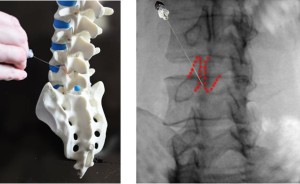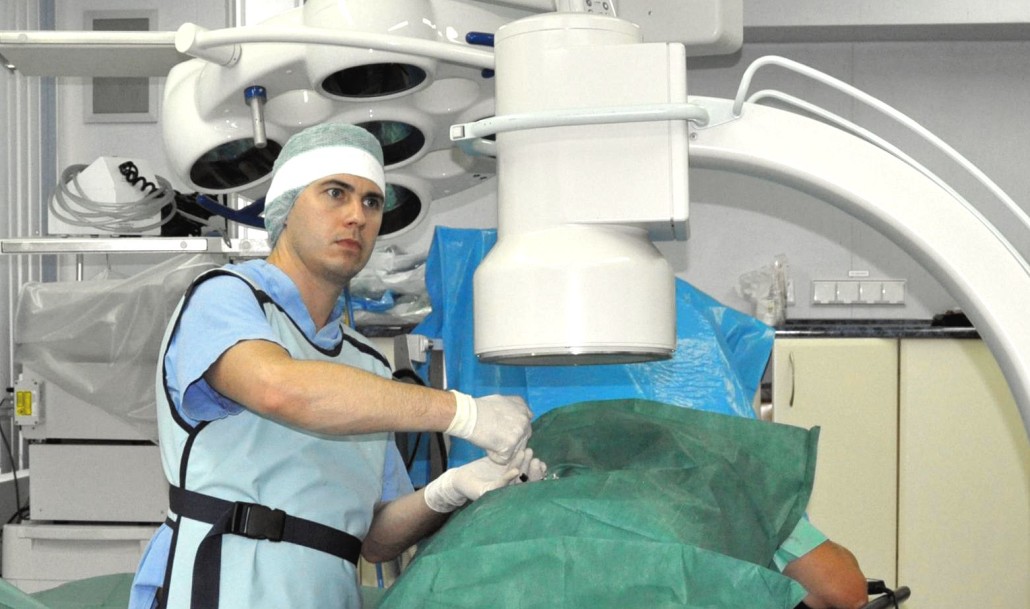- The first and only medical facility in the region that uses DISCOGEL,
- Highest quality X-ray and ultrasound equipment,
- Modern and safe methods

There are many reasons for back pain, which may result both from our everyday functioning as well as from degenerative changes occurring in time.
The main reasons for back pain are:
- damages to intervertebral disc
- intensive training without proper warm up
- lack of physical activity
- obesity
- lack of proper posture
Nerve root pain:
It is caused by pressure applied on the nerve roots. Beginning with the premature degeneration of the spine
 Such pain can be felt as:
Such pain can be felt as:
- axial – occurring during prolonged standing, sitting, excessive load,
- radiating to the upper or lower limbs – in the case of an intervertebral disc hernia
- both axial and radiating pain are very onerous and usually last for several days, which is accompanied by a feeling of limb numbness or sensation.
Modern methods of treating spinal pain syndromes focus removing the cause of pain.
Blockade (Selective Cervical Nerve Root Blockade)
Selective Cervical Nerve Root Blockade is a precise and direct administration of the drug to the source of pain. The blockage is used when the displaced disk applies pressure to the spinal nerves and the tire sack. The pain is then caused both by mechanical pressure and swelling.
Therefore, an effective and safe method of treatment for the above-mentioned symptoms is to administer the drug directly to the source of pain.
At the Dom Lekarski Medical Center, the procedure is performed with help of an X-ray machine, which supports the current position control of the needle.

In the case when the cause of pain (pain generator) is a degenerative disease of the spinal joints, a similar procedure can be performed by sharpening the spinal joints of the spine.
What types of drugs are used in spinal blockades?
The most commonly used drugs in selective spinal blockades include:
- local anesthetic drugs with long-term effect,
- anti-inflammatory drugs from the group of corticosteroids,
- Orthokine®.
- Anesthetics exert a local analgesic effect and regenerate hypoxia nerves, for example under pressure.
- Medicines from corticosteroid groups strongly limit inflammatory processes, which limits secondary nerve damage and its further irritation.

wstrzykiwania blokady transforaidalnej
An alternative method is to use Orthokine®.
It works by blocking the pro-inflammatory cytokine that stimulates and sustains inflammatory processes. The effect of this therapy is to silence inflammatory processes and stimulate self-healing. In addition, this preparation is of autogenic origin, i.e. it is obtained from the patient’s blood, so there are no contraindications to its use even in the case of metabolic diseases (diabetes, hypertension, unstable ischemic heart disease, hormonal disorders).
How long do the locks last?
Several factors influence the longevity of the analgesic effect:
– duration of symptoms – chronic perennial pain usually requires several injections at intervals of 1-2 weeks to achieve the full therapeutic effect;
– advanced disease – patients with many degenerative changes of the spine maintain the therapeutic effect shorter than patients with changes in one or two segments;
– patient’s age – patients under 60 enjoy longer pain relief;
Therefore, depending on all these factors, the patient can enjoy the therapeutic effect from 6 months to even 2 years from the date of injection, but it should be remembered that each case is a matter of individual case of a given patient.
DiscoGEL® – the first, precise method of treating discopathy (collapse of the disk)
DiscoGEL® is an innovative, non-surgical, performed under local anesthesia, a method of treatment of discopathy. It is a gel implant injected percutaneously into the nucleus of the intervertebral disc. This implant is created on the basis of ethanol and cellulose-derived products, thanks to which its action is based on two activities:
- mechanical – thanks to the hydrophilic properties DiscoGEL® causes the migration of fluid into the center of the disk, which relieves the nervous structures
- biochemical – DiscoGEL® blocks the pain receptors.
The result is immediate pain reduction.
The advantages of this non-surgical method are primarily:
– minimal risk of complications: septic, inflammatory, postoperative pain;
– protection of surrounding tissues;
– excellent tolerance: no known allergic reactions;
– minimally invasive technique performed under local anesthesia;
– lack of postoperative scars;
– the possibility of treating hernias on multiple levels of the spine during one treatment;
– quick relief of nerve structures;
– very short recovery time;
– full interentricular monitoring using radioscopy thanks to the X-ray marker included in DiscoGEL®
Cryoneurolysis
Cryoneurolysis is a procedure that temporarily block nerves conductions to eliminate pain using low temperatures.
Thanks to cryoneurolysis, patient no longer feels pain which helps him to achieve better results during his rehabilitation and in the end get rid of the pain forever.
Advantages:
- its reversible
- minimally invasive
- efficient and effective
- full control
- helps rehabilitation process
- no complications
| PON | WT | ŚR | CZW | PT | |
| Md Łukasz Terenowski | - | - | - | - | 9/25/18 15:00 - 9/25/18 20:30 |
Podane godziny przyjęć są orientacyjne i mogą ulec zmianie.
